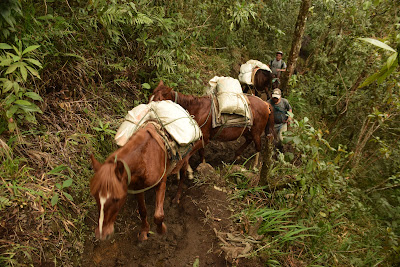SAJSIB'AN- The name means white rock in in Ixil and is the name of one of villages eight miles west of our farm. The village is named after six vertical stones that lie in the forested peak behind the men in this photo. The stones were erected around 250 A.D. during the classic period of Mayan history. The remoteness of the site and the height above the surrounding valleys give certainty that the site was used as for sacred ceremonies. This last year as we hiked and worked in these mountains to bring water to the 357 homes of Sajsib'an it still held a sacredness. The natural beauty, the effort men of the village, the shear immensity of the project and the goal to meet such a basic need all added to reinforce the feeling. I invite you to celebrate with us and our sponsors- The Carson Foundation, Rotary Gig Harbor, Gary Glen Foundation and the Anderson family- the completion of the
SAJSIB'AN WATER PROJECT 2019
for
357 HOMES and 1,600 HAPPY BENEFICIARIES


It sounds so sure and simple. A gravity feed water system. Collecting the spring water in the picture to the right and passing it through piping to reach the tank site on the left. But what the two picture don't show is the three hours of hard hiking full of ravines, landslides, old growth tree roots and rocks that lie between them making this a epic task.
To be able to successfully work in community development take vision and commitment not only from the organization that desires to help but from the community leaders themselves.
I would like to include on our thanks some of the men in this picture. Over four years ago Diego and Roberto searched the mountains for a spring to service the village. They latter organized the village in the purchase of the spring and brought a project request to our office.


Really there was no trail other than the one we made buy our constant journeys.


Collection tanks are always kept simple so as not to disturb the site more than necessary. The location of this spring was on such a steep hillside that a wood platform built on stilts was needed to mix the cement on. From the mixing platform you can see the white of a concrete tower on the other side of the ravine. To cross the distance between the two points a 60 meter cable will be needed to hang the pipe from.

Hanging pipe from a simple cart we constructed over one of the ravines. You can see the concrete tower used to support the cable and a crew of men on the other side. This is the second ravine we crossed.
Pieces of rebar were bent to form hooks to hang the pipe on.

The first crossing with the spring in the distance Pulling cable took many hands
By teamwork and dedication after three months of work we passed through forest to the tank site.
The site chosen for the tank was still half an hour hike above the village. The village leaders wanted to construct the tank there to allow for future growth of the village above the present homes.
After excavating the tank site a grid of rebar was tied in place.

700 more bags of sand, gravel and cement were carried to be used in the construction of the 21 foot square holding tank.
Hand mixing the cement was a whole village effort with around a 100 men present each day.
After completing the wall forms our two local masons we employed sit for a photo.
They take pride in their part building a quality crafted water tank and along with the rest of the men they have memory that will follow them throughout their lives. "Remember when we built our water system." This type of healthy ownership is built by being sweat partners in the work.

I would like to invite you to see some of the faces of the workers who with the help of our international sponsors have done what many would say could not be done. It has taken a huge effort and $50,000 but one village celebrates every time each family member opens a faucet of clean running water and this celebration will continue though the years to come.


They take pride in their part building a quality crafted water tank and along with the rest of the men they have memory that will follow them throughout their lives. "Remember when we built our water system." This type of healthy ownership is built by being sweat partners in the work.

I would like to invite you to see some of the faces of the workers who with the help of our international sponsors have done what many would say could not be done. It has taken a huge effort and $50,000 but one village celebrates every time each family member opens a faucet of clean running water and this celebration will continue though the years to come.









From the village of Sajsib'an, high in the mountains of Guatemala to all our supporters
TANTIUXH
THANK YOU

























No comments:
Post a Comment